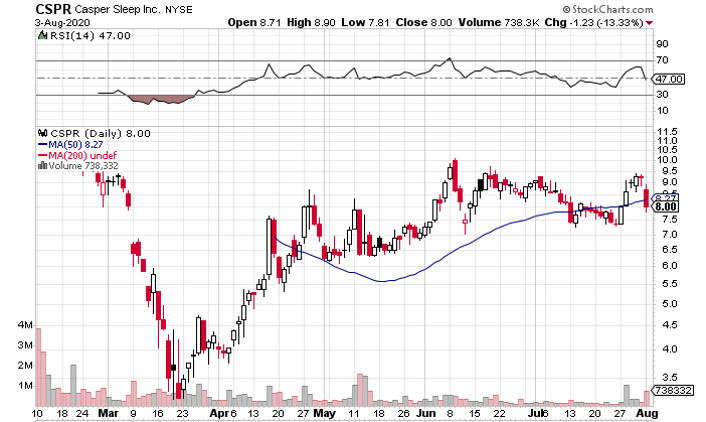Casper NASDAQ: CSPR plunged 13% on more than double its average volume yesterday, just one day before the mattress startup’s lock-up period expires. Investors rushed to the exits before insiders are allowed to sell their shares.
While Casper is currently losing money, e-commerce was largely responsible for impressive revenue growth in Q1. With Q2 earnings set to be released next week, are we looking at an excellent opportunity to pick up shares at a discount?
Casper NASDAQ: CSPR Q1 2020 Numbers
Casper’s sales surged more than 26% yoy in Q1 to $113 million. Direct-to-consumer sales through e-commerce and branded stores were up 12.8% to $90.3 million, while sales to retail partners soared 142.9% to $22.7 million.
In April, overall sales were up 15% and e-commerce sales rose 35%, even though all of Casper’s own stores were closed. This indicates that Casper’s sales should not be impacted by future waves of the pandemic.
But earnings are another story:
In Q1, general and administrative costs as a percentage of revenue jumped from 34.5% to 42.7%. Casper’s adjusted EBITDA loss widened to $22.9 million from $14.3 million. Net loss, on a GAAP basis, was $1.23 per share.
On the one hand, Casper laid off 21% of its corporate workforce and decreased capital expenditures; these two measures should help to reign in expenses.
But on the other hand, the mattress startup has invested a lot of money into marketing to compete with the established mattress retailers. These marketing costs go hand-in-hand with Casper’s revenue growth; without them, the startup would struggle to take market share.
The good news is that Casper expects high revenue growth moving forward, and marketing costs should decrease as a percentage of revenue in the long run. Combine that with the greater efficiency in operations that normally occurs as a company matures, and Casper should be able to turn its losses into profits over the next couple of years.
Casper NASDAQ: CSPR A Path Towards a Reasonable Valuation
Casper is projected to record a loss of $2.43 per share in 2020, and while it is also expected to record a loss in 2021, it’s projected to contract to a loss of $1.59 per share.
But revenue is expected to come in around $505 million for full-year 2020 and increase to around $622 million in 2021. With a market cap of a little over $300 million, Casper is trading at around .5x 2021 sales.
It’s impossible to say exactly how Casper’s margins will look in a few years. But it wouldn’t take a high margin for Casper to trade at a very reasonable P/E ratio.
Doing some back of the envelope calculations, if Casper got up to a (reasonable) 4% net profit margin, it would earn around $25 million on sales of $622 million.
At its current valuation, that would equate to a P/E ratio of less than 13.
Of course, there is no way of knowing if Casper will reach a 4% margin, but it’s very realistic. Furthermore, it’s possible (even likely) that revenue will continue growing well past $622 million over the next 3-5 years.
Bottom line, I wouldn’t bet the house on Casper, but it’s a solid risk/reward at these levels and can easily turn into a multi-bagger.
Where Can You Get In?
As touched on earlier, Casper shares had a tough day yesterday. And the move also took shares below the 50-day moving average, a bearish sign.
It’s impossible to say if this sell-off will continue but getting in right now would be too much of a gamble.

Instead, look for shares to stage a reversal. For example, if CSPR moves down around 5% more, but closes near the highs of the day’s session, there’s a good chance the sell-off has run its course. At that point, you could get in and place a stop-order just under the lows of the reversal day.
Alternatively, you could wait for CSPR to break out of its base between $7 and $10 a share. With earnings set to be released next week, a blowout report could send CSPR above $10 a share.
Either option makes sense; it all depends on your risk tolerance and purchase preferences.
The Final Word
If Casper’s powerful revenue growth continues and margins approach the mid-single digits over the next few years, shares will look like an incredible value at current levels.
But if earnings don’t come to fruition, which is very possible, shares would have a lot of potential downside.
The best move on CSPR is to look to initiate a small position and place a stop-order within 5-12% of your purchase price. This way, you are exposed to its high upside, but your risk is limited.
Before you make your next trade, you'll want to hear this.
MarketBeat keeps track of Wall Street's top-rated and best performing research analysts and the stocks they recommend to their clients on a daily basis.
Our team has identified the five stocks that top analysts are quietly whispering to their clients to buy now before the broader market catches on... and none of the big name stocks were on the list.
They believe these five stocks are the five best companies for investors to buy now...
See The Five Stocks Here
Enter your email address and we'll send you MarketBeat's guide to investing in 5G and which 5G stocks show the most promise.
Get This Free Report